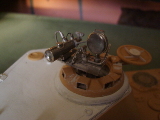
Panzerkampfwagen V Panther II
(Prototype) In late 1942, German designers started the development of more powerful and slightly larger version of Panther mounted on a newly designed chassis. In January of 1943, Adolf Hitler agreed on the development of Panther with increased armor protection especially for the needs of the Eastern Front. This project was designated Panther (2) II and its design was planned along with the development of Tiger II . In February of 1943, it was decided that Panther II , in its design would resemble Tiger II and would have many common components such as: tracks, transmission, suspension and roadwheels. Both designs had common components in an attempt to standardize the production. Overall dimensions were very similar to those of Panther Ausf G . Hull's design was very similar to that of the late model Panther Ausf G but with many modernizations such as the arrangement of observation equipment and new engine deck. Its armor protection was significantly increased if compared to any other Panther variant produced. Side armor protection was 60mm thick while frontal armor protection was 100mm thick. It was planned to arm Panther II with the latest 75mm KwK 42 L/100 or even 88mm KwK 43 L/71 (without muzzle break) gun mounted in newly designed narrow turret - Schmalturm (designed by Rheinmetall in 1944 and to be produced by Daimler-Benz). Panther II 's Schmalturm (narrow) turret was slightly different than that of Panther Ausf F . Turret's armor protection was significantly increased if compared to any other Panther turret. Front was 120-125mm, gun mantlet was 150mm, while sides and rear were 60mm and top was 30mm thick. Schmalturm had special mountings for infrared device and telescopic range finder. All of those modifications increased Panther II's weight to 47 tons. Panther II was to be powered by new Maybach HL234 engine with total power of 900hp operated by 8-speed hydraulic transmission. Instead Maybach HL 230 P 30 engine was mounted and Maybach HL234was later on due to be completed in August of 1945, for future Panther series. It was believed that Panther II's performance would be similar to that of Panther Ausf G, while if ever produced Panther II would most likely suffer from the same problems as Tiger II . Simply because of its great weight and high fuel consumption which made it extremely slow. It is also unknown what other modifications would be made if Panther II would be combat tested. In March of 1943, plans were laid that the production of first series would start in late 1943 or early 1944 and that by spring of 1944, full scale production of Panther II would start. On May 20th of 1943, Rheinmetall-Borsig proposed special air-defence turret designed for Panther II , mounted with four 20mm MG151/20 guns but it never reached prototype stage. In early 1944, MAN (Maschinenfabrik Augsburg-Nuremberg) was allowed to produce two prototypes but was only able to produce one in early 1945, without newly designed Schmalturm turret. On May 4th of 1944, it was realized that German industry was unable to start Panther II 's production and this project was abandoned in favour of further development of Panther Ausf G/F based on lessons learned from Panther II. On June 3rd of 1944, all companies which were to produce Panther II, were ordered to start the production Panther. Since turret's design was never completed, for test purposes prototype Panther II was fitted with newly built Ausf G turret (built in March/April of 1945) armed with 75mm KwK 42 L/70 gun and with special mountings for infrared device and telescopic range finder. It is possible that it was used in combat but there is no records of it, while some sources state that Ausf G turret was fitted by the Americans after the chassis was captured. German designers planned to build Jagdpanther II armed with 128mm gun based on Panther II but its design never reached prototype stage.Only one prototype built was captured by American Army and was transported to Aberdeen U.S Army Proving Grounds (Maryland) for tests. Later on it was taken to Patton Armor Museum in Fort Knox, where it restored and remains on display. (info from www.achtungpanzer.com) |
|
Quite pleased with the finished model, turned out nice! |
The turret had to be totally re-built using the side plates of the original panther turret as the only original parts! |
The likeness to the King Tiger turret is apparent when you check out the overall look
|
Site Design By Skud © Bulldog Models 2006 -2007 |
TN.jpg)
TN.jpg)
TN.jpg)
TN.jpg)

TN.jpg)
TN.jpg)
TN.jpg)
TN.jpg)
TN.jpg)
TN.jpg)
TN.jpg)
TN.jpg)
TN.jpg)
TN.jpg)
TN.jpg)
TN.jpg)
TN.jpg)
TN.jpg)
TN.jpg)
TN.jpg)